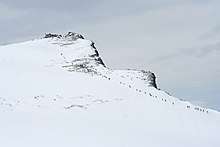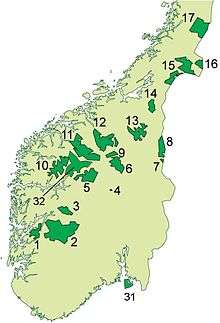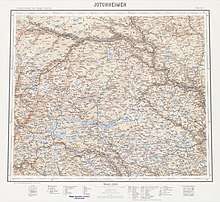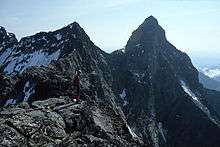Jotunheimen
Jotunheimen is Norway's most famous mountain area, most of which is protected as a national park. This mountain range includes the highest summits in Norway (and Northern Europe) and some of the wildest alpine areas in Norway. While a few summits are only accessible by climbers, most of the area can easily be hiked by most visitors with proper boots and fitness. Glaciers can only be traversed with a guide and proper equipment. The name "Jotunheimen" has its roots in Norse mythology, and literally means "The home of the giants" (the mountain range was previously referred to as "Giant Mountains"). Jotunheimen is part of a long, virtually continuous line of mountains separating East Norway from coastal and fjord districts of Middle Norway and West Norway. Hardangervidda and Dovrefjell are other important parts of this great barrier. The western most part of Jotunheimen sits at the intersection with the great Sognefjord and the fjord's adjacent valleys. The eastern part of Jotunheimen rises gradually above the mountain plateau west of road 51. Road 55 marks the northern limit of Jotunheimen, while roads E16 and 53 mark the southern limit.

Understand

.jpg)
History
Several English and German noblemen used to visit Jotunheimen in late 1800s and early 1900s to explore the mountain area, and climb the mountains. The Norwegian poet Vinje named many of the peaks in the western part of the park and is justly celebrated with a monument near Fondsbu DNT Hut. The Norwegian national playwright Ibsen set one of the most famous scenes in his classic Peer Gynt on the dramatic Besseggen Ridge in the eastern part of the park. The Besseggen Ridge has become one of the most visited natural attractions in Norway with 1–2 people passing any given point every 2–3 minutes in high summer – not a place for solitude! The eccentric Englishman HC Slingsby popularised the area through his trip reports published in the Scottish Mountaineering Journal in the 1880s and 1890s. He also published a classic book-length account entitled Norway: the northern playground. Three in Norway (by two of them) (written by Lees and Clutterbuck, 1882) is a classic travelogue about a long summer and early autumn spent mostly around Gjende lake.
Landscape
Jotunheimen has alpine mountains, glaciers with lakes and small rivers. Utladalen canyon, the deepest valley in Norway, runs like a deep crack between Western and Eastern Jotunheimen.

Flora and fauna
This is a high mountain area with very few trees, mostly heathery terrain with some bushes.
Climate
Rapid weather changes can occur, there are lots of snow in the winter due to the high altitude, the summer is nice with up to over 25 °C (80 °F) when there is good and sunny weather. Note that at higher altitudes deep snow can remain from winter until midsummer. The hiking season varies, but usually starts in late June, while July–August are the best months. Visitors should obtain specific information about snow conditions if they plan to hike in June. Utladalen valley is largely lowland and can be visited in May.
Get in

Jotunheimen can be accessed from north and south. From Oslo it is about 380 km to the north (Lom) and about 230 km to the south (Beitostølen) or 265km to Tyinkrysset.
By car
There are no roads within the boundaries of the national park.
- Road E16 (Filefjell mountain pass) runs on the south edge of area
- Road 51 (Valdresflye pass) runs on the eastern side, this road climbs to about 1400 meters and allows a high starting point
- Road 55 (Sognefjellet pass) runs on the western edge, this road climbs to almost 1500 meters and allows a high starting point
- The private road to Juvasshytta climbs to 1800 meters and gives a relatively short walk to Galdhøpiggen, there is also a summer skiing resort.
- Road 53 (Årdal-Tyin road) offers good access from low starting point in Årdal (Utladalen valley in particular) and from Tyin lake a high starting point.
- Road to Eidsbugarden, summer only, no asphalt
By train
Train from Oslo and Gardermoen Airport to Otta 300km north of Oslo and take bus 80km west to Lom.
By bus
- Nor-Way Bussekspress (express buses). Most express buses running through the region are operated by this company. Connections to Oslo, Lillehammer, Sogn, Trondheim and Nordfjord.
- Valdresekspressen (express coach), ☎ +47 61 36 59 00, fax: +47 61 36 16 00, e-mail: post@valdresekspressen.no. Route (Up to five daily departures): Oslo-Hønefoss-Valdres-Beitostølen-Gjendesheim (only summerseason to Gjendesheim) and Oslo-Hønefoss-Valdres-Tyinkrysset-Tyin-Årdal..
- Øst-Vest Xpressen (express coach), ☎ +47 61 36 59 00, fax: +47 61 36 16 00, e-mail: jvb@jvb.no. Route (One departure per day): Bergen-Voss-Lærdal-Tyinkrysset-Fagernes-Lillehammer..
- Snowmobile (snowmobile), ☎ +47 61 36 59 00, fax: +47 61 36 16 00, e-mail: jvb@jvb.no. Connections: Tyin-Tyinholmen-Eidsbugarden (Fondsbu) and Beitostølen-Bygdin. In summerseason there is a local bus-service on those two routes..
- Bus through the Sognefjellet mountain pass from Sogndal and Luster to Otta and Lom, operated by Nettbuss (updated 2016).
Fees and permits
If you want to fish, there is a small fee. Contact the local tourist information for more details. Hiking, skiing etc. is free, but in many cases you will want to join a tour or hire a guide.
Get around

The only way to travel within Jotunheimen national park is by foot or by cross-country skis. The DNT (the Norwegian Trekking Association) has a network of hiking routes with accommodation in Jotunheimen.
Outside the boundaries of the park there are roads partly into area, for instance the private road to Juvasshytta, the public road to Eidsbugarden (along Tyin lake), the private Tindevegen between Årdal and Turtagrø (in Luster).

See

A fabulous alpine mountain area; probably the best in the whole of Scandinavia. There are countless glaciers, emerald lakes, summits and steep cliffs. Most of the area is protected as national park or landscape park.
While the national park itself is not available by car or bus, mountain range can be seen from roads at the perimeter: E16 and county roads 51 (Valdresflya) and 55 (Sognefjellet). The pivate road Tindevegen between Turtagrø and Årdal perhaps offers the best view as it runs on the western edge of Hurrungane group (western Jotunheimen).
Do
Here you can go hiking both in summer and by cross country skiing in the winter. Several possibilities of guided glacier hiking and guided climbing in the high mountains.
In Jotunheimen you can climb several alpine mountains. Jotunheimen's highest mountain is 🌍 Galdhøpiggen at 2469m above sea level. Galdhøpiggen is also the highest mountain in Norway and in Europe north of the Alps. Second highest is 🌍 Glittertind with 2464m. These are both long, but technically easy hikes. One of the most famous hiking routes in Jotunheimen is across 🌍 Besseggen, a narrow edge with steep cliffs on both sides. The most famous mountain where you have to climb to get to the top, is 🌍 Store Skagastølstind (2405m).
Buy
Eat
What you bring with you, or buy at the local hotels in the park. Try elk burgers or reindeer steak.
Drink
Water from rivers and streams is generally safe and of high quality. Rivers lower than settlements and farms should be avoided. Streams flowing from barren high mountains have good water. Glacial melt water may irritate some stomachs.
Sleep
There are several places where you can get accommodation in the mountain, both full service mountain hotels and self service cabins. Visit DNT (the Norwegian Trekking Association) for more information.
Lodging
Camping
Backcountry
Wild camp. Not more than three days in a row on the same spot and at least 150 meters from buildings.
Stay safe
.jpg)
Always bring a map (1:50,000 or 1:75,000) and a compass – even if you have a satellite navigator (GPS) – and pay attention to the local weather forecasts. Always remember to tell where you go and when you expect to arrive there, to someone who has enough info to summon help if you do not show up. Talk to locals if you are in doubt. While a national park, there are generally no guards or fences, visitors are expected to take care of themselves. Jotunheimen is mostly above the treeline and the surface is rugged with rocks, boulders, snow and glaciers; sturdy boots are needed to walk safely and weather can be cold and rough even in midsummer.
For hiking over glaciers you need a guide unless you are experienced enough yourselves. The same applies if you are going on other types of demanding hikes or do not know what to expect. Note the risk for avalanches